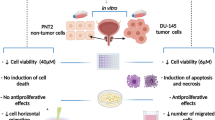Abstract
Treatment of androgen-independent prostate cancer (AIPC) remains unsatisfactory. In our present experiment, natural occurring ginsenosides (NOGs) and intestinal bacterial metabolites (IBMs) were employed to investigate their anti-AIPC cell growth activity using PC-3 cells. Our results showed that the IBMs exerted more portent anti-AIPC activity than NOGs, by decreasing survival rate, inhibiting proliferation, inducing apoptosis, and leading to cell cycle arrest in AIPC PC-3 cells. The increase of LogP and decrease of C-6 steric hindrance, which were caused by deglycosylation by intestinal bacteria, may be the reason for the higher anti-AIPC activity of IBMs.
Similar content being viewed by others
References
Aragon-Ching, J. B. and Dahut, W. L., Chemotherapy in Androgen-Independent Prostate Cancer (AIPC): What’s next after taxane progression? Cancer Ther, 5A, 151–160 (2007).
Byun, B. H., Shin, I., Yoon, Y. S., Kim, S. I., and Joe, C. O., Modulation of protein kinase C activity in NIH 3T3 cells by plant glycosides from Panax ginseng. Planta Med, 63, 389–392 (1997).
Cao, J., Liu, Y., Jia, L., Zhou, H. M., Kong, Y., Yang, G., Jiang, L. P., Li, Q. J., and Zhong, L. F., Curcurnin induces apoptosis through mitochondrial hyperpolarization and mtDNA damage in human hepatoma G2 cells. Free Radical Biology and Medicine, 43, 968–975 (2007).
Gross, A., McDonnell, J. M., and Korsmeyer, S. J., BCL-2 family members and the mitochondria in apoptosis. Genes Dev, 13, 1899–1911 (1999).
Hasegawa, H., Proof of the mysterious efficacy of ginseng: basic and clinical trials: metabolic activation of ginsenoside: deglycosylation by intestinal bacteria and esterification with fatty acid. J Pharmacol Sci, 95, 153–157 (2004).
Hasegawa, H., Sung, J. H., Matsumiya, S., and Uchiyama, M., Main ginseng saponin metabolites formed by intestinal bacteria. Planta Med, 62, 453–457 (1996).
Kang, K. A., Kim, Y. W., Kim, S. U., Chae, S., Koh, Y. S., Kim, H. S., Choo, M. K., Kim, D. H., and Hyun, J. W., G1 phase arrest of the cell cycle by a ginseng metabolite, compound K, in U937 human monocytic leukamia cells. Arch Pharm Res, 28, 685–690 (2005).
Keepers, Y. P., Pizao, P. E., Peters, G. J., van Ark-Otte, J., Winograd, B., and Pinedo, H. M., Comparison of the sulforhodamine B protein and tetrazolium (MTT) assays for in vitro chemosensitivity testing. Eur J Cancer, 27, 897–900(1991).
Kim, H. S., Lee, E. H., Ko, S. R., Choi, K. J., Park, J. H., and Im, D. S., Effects of ginsenosides Rg3 and Rh2 on the proliferation of prostate cancer cells. Arch Pharm Res, 27,429–435 (2004).
Li, G., Wang, Z., Sun, Y., Liu, K., and Wang, Z., Ginsenoside 20(S)-protopanaxadiol inhibits the proliferation and invasion of human fibrosarcoma HT1080 cells. Basic Clin Pharmacol Toxicol, 98, 588–592 (2006).
Liu, W. K., Xu, S. X., and Che, C. T., Anti-proliferative effect of ginseng saponins on human prostate cancer cell line. Life Sci, 67, 1297–1306 (2000).
Liu, Y., Li, W., Li, P., Deng, M. C., Yang, S. L., and Yang, L., The inhibitory effect of intestinal bacterial metabolite of ginsenosides on CYP3A activity. Biol Pharm Bull, 27,1555–1560 (2004).
Liu, Y., Ma, H., Zhang, J. W., Deng, M. C., and Yang, L., Influence of ginsenoside Rh1 and F1 on hu-man cytochrome p450 enzymes. Planta Med, 72, 126–131 (2006a).
Liu, Y., Zhang, J. W., Li, W., Ma, H., Sun, J., Deng, M. C., and Yang, L., Ginsenoside metabolites, rather than naturally occurring ginsenosides, lead to inhibition of human cytochrome P450 en-zymes. Toxicol Sci, 91, 356–364 (2006b).
Ly, J. D., Grubb, D. R., and Lawen, A., The mitochondrial membrane potential (deltapsi(m)) in apoptosis; an update. Apoptosis, 8, 115–128 (2003).
Lyons, A. B. and Parish, C. R., Determination of lymphocyte division by flow cytometry. J Immunol Methods, 171, 131–137 (1994).
Odashima, S., Ohta, T., Kohno, H., Matsuda, T., Kitagawa, I., Abe, H., and Arichi, S., Control of phenotypic expression of cultured B16 melanoma cells by plant glycosides. Cancer Res, 45, 2781–2784 (1985).
Oh, S. H. and Lee, B. H., A ginseng saponin metabolite-induced apoptosis in HepG2 cells involves a mitochondria-mediated pathway and its downstream caspase-8 activation and Bid cleavage. Toxicol Appl Pharmacol, 194, 221–229 (2004).
Popovich, D. G. and Kitts, D. D., Structure-function relationship exists for ginsenosides in reducing cell proliferation and inducing apoptosis in the human leukemia (THP-1) cell line. Arch Biochem Biophys, 406, 1–8 (2002).
Tawab, M. A., Bahr, U., Karas, M., Wurglics, M., and Schubert-Zsilavecz, M., Degradation of ginsenosides in humans after oral administration. Drug Metab Dispos, 31, 1065–1071 (2003).
Wakabayashi, C., Murakami, K., Hasegawa, H., Murata, J., and Saiki, I., An intestinal bacterial metabolite of ginseng protopanaxadiol saponins has the ability to induce apoptosis in tumor cells. Biochem Biophys Res Commun, 246,725–730 (1998).
Wang, W., Wang, H., Rayburn, E. R., Zhao, Y., Hill, D. L., and Zhang, R., 20(S)-25-methoxyl-dammarane-3beta, 12beta, 20-triol, a novel natural product for prostate cancer therapy: activity in vitro and in vivo and mechanisms of action. Br J Cancer, 98, 792–802 (2008).
Wang, W., Zhao, Y., Rayburn, E. R., Hill, D. L., Wang, H., and Zhang, R., In vitro anti-cancer activity and structure activity relationships of natural products isolated from fruits of Panax ginseng. Cancer Chemother Pharmacol, 59,589–601 (2007).
Yang, Z. G., Sun, H. X., and Ye, Y. P., Ginsenoside Rd from Panax notoginseng is cytotoxic towards HeLa cancer cells and induces apoptosis. Chem Biodivers, 3, 187–197 (2006).
Yu, Y., Zhou, Q., Hang, Y., Bu, X., and Jia, W., Antiestrogenic effect of 20S-protopanaxadiol and its synergy with tamoxifen on breast cancer cells. Cancer, 109, 2374–2382 (2007).
Author information
Authors and Affiliations
Corresponding author
Rights and permissions
About this article
Cite this article
Li, W., Liu, Y., Zhang, JW. et al. Anti-androgen-independent prostate cancer effects of ginsenoside metabolites In Vitro: Mechanism and possible structure-activity relationship investigation. Arch. Pharm. Res. 32, 49–57 (2009). https://doi.org/10.1007/s12272-009-1117-1
Received:
Revised:
Accepted:
Published:
Issue Date:
DOI: https://doi.org/10.1007/s12272-009-1117-1




